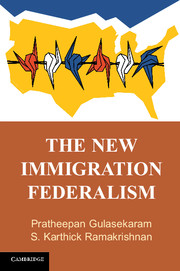Book contents
- Frontmatter
- Dedication
- Contents
- List of Figures and Tables
- Acknowledgments
- 1 Introduction
- 2 Setting the Stage for the New Immigration Federalism
- 3 Rise of Restrictive Legislation and Demographic Arguments of “Vital Necessity”
- 4 A Political Theory of Immigration Federalism: The Polarized Change Model and Restrictive Issue Entrepreneurs
- 5 A Shifting Tide in 2012: Pro-Integration Activists Gain the Upper Hand
- 6 Implications for Legal Theory on Federalism and Immigration Law
- 7 Immigration Federalism Is Here To Stay
- Appendix A Statistical Analysis of Restrictive Local Ordinances
- Appendix B Statistical Analysis of Restrictive State Laws
- Appendix C Statistical Analysis of State Immigrant Integration Laws
- Notes
- Index
2 - Setting the Stage for the New Immigration Federalism
Published online by Cambridge University Press: 05 November 2015
- Frontmatter
- Dedication
- Contents
- List of Figures and Tables
- Acknowledgments
- 1 Introduction
- 2 Setting the Stage for the New Immigration Federalism
- 3 Rise of Restrictive Legislation and Demographic Arguments of “Vital Necessity”
- 4 A Political Theory of Immigration Federalism: The Polarized Change Model and Restrictive Issue Entrepreneurs
- 5 A Shifting Tide in 2012: Pro-Integration Activists Gain the Upper Hand
- 6 Implications for Legal Theory on Federalism and Immigration Law
- 7 Immigration Federalism Is Here To Stay
- Appendix A Statistical Analysis of Restrictive Local Ordinances
- Appendix B Statistical Analysis of Restrictive State Laws
- Appendix C Statistical Analysis of State Immigrant Integration Laws
- Notes
- Index
Summary
Throughout this book, we refer to the most recent (and current) surge in state and local immigration regulation as the “new immigration federalism.” Others have termed the conspicuous increase in state and local laws over the past decade as the “subfederal immigration revolution.” In historical perspective, however, the presence of state and local regulation of immigration is not entirely new, as the mid-1800s saw some important developments in state immigration policies. At the same time, a historical review provides us with an opportunity to detect the ways in which the immigration federalism of yore compares to the new immigration federalism of today, and to consider key legislative and judicial developments that have altered the trajectory of how states and localities have gotten involved.
Here, we present an abridged narrative of the political and legal development of immigration federalism in American history. We divide this review into three separate eras, starting with the first century of immigration federalism, spanning the Founding to 1875, the era famously dubbed the “Lost Century” of immigration law by Professor Gerald L. Neuman. Next, we move to the second period of immigration federalism, which we argue constitutes another century with some clear indications of beginning and end points, from 1875 to 1965. Finally, we explore the third era of immigration federalism, from 1965 onward. Here, we summarize the legal developments and state responses that preceded 9/11, and helped set the stage for the new surge in immigration federalism that began after 2004 and continues apace, with various legal and political twists along the way. In Chapters 3, 4, and 5, we draw more detailed attention to these post-9/11 dynamics of political and legal developments, including the Supreme Court's 2012 Arizona v. United States decision and the more recent push toward more pro-integration legislation.
During the first century of immigration law, states and localities were virtually the exclusive regulators of immigration. State and local controls on the movement and entry of persons operated as immigration law from 1776 to 1875. Starting in 1875, however, both the politics and legal presumptions regarding state involvement in immigration began to change rapidly.
- Type
- Chapter
- Information
- The New Immigration Federalism , pp. 12 - 56Publisher: Cambridge University PressPrint publication year: 2015



